
How to Manage Business Listings Properly
Last updated on October 31st, 2025
In today’s digital-first world, your local business listings are more than just an online address book entry; they are powerful tools for visibility, customer engagement, and ultimately, growth. But what exactly does listings management entail, and why is it so crucial for your local SEO success?
What is listings management?
Listings management is the process of creating, updating, and optimizing your business information across a multitude of online platforms. This includes major search engines like Google, Bing, and Apple Maps, social media sites like Facebook, and countless online directories and review sites.
The goal is to ensure that your Name, Address, and Phone number (NAP) are consistent and accurate everywhere your business is found online, along with other important details such as opening hours, services, photos, and customer reviews.
Listings management also includes monitoring suggested edits, tracking performance, and proactively responding to customer interactions, helping you to present a reliable and trustworthy brand.
How it Differs from Building Citations
While often used interchangeably, ‘listings management’ and ‘citation building’ are two different but related practices.
Citation building primarily focuses on creating new citations (mentions of your business’s NAP) on various directories and platforms. It’s about establishing a foundational presence and expanding your reach.
Listings management, on the other hand, is an ongoing, proactive activity. It includes not only building new citations but also monitoring existing ones, ensuring their accuracy, optimizing them for search, responding to reviews, and managing any suggested or external edits that may arise.
In short, citation building is one of the activities involved in listings management.
Why You Need It
Proper listings management isn’t just a best practice; it’s necessary for any local business aiming to thrive online. Here’s why:
- Boosts Search Visibility: Accurate and optimized listings show search engines that your business is legitimate and trustworthy, leading to higher rankings in local search results and maps. Plus, AI search engines use these as sources for information, too.
- Helps New Customer Discovery: When potential customers search for businesses, complete and optimized listings make it easier for them to find you, understand what you offer, and choose you over competitors.
For example, according to our
Local Business Discovery and Trust Report, 61% of consumers use business information sites to discover new local businesses.
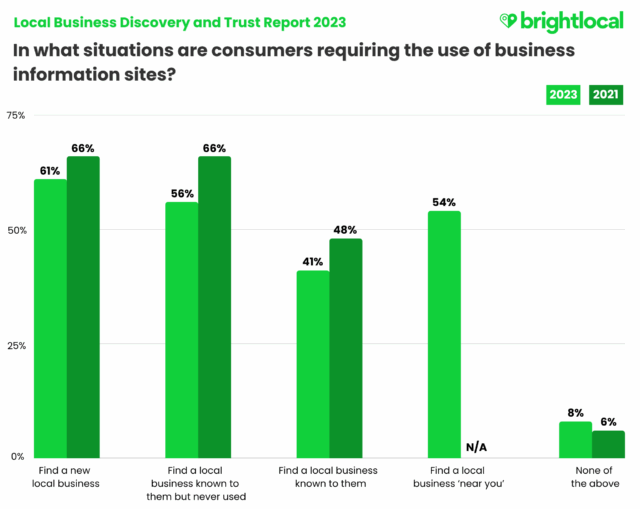
- Provides Essential Customer Information: Online listings give potential customers key information like your hours, phone number, and location, making it easier for them to decide to become customers.
- Enhances Customer Trust and Experience: Inaccurate information can frustrate customers and damage your reputation. In fact, BrightLocal’s Local Business Discovery and Trust Report 2023 reveals that 62% of consumers would avoid using a business if they found incorrect information online. Consistent and reliable listings build trust and provide a seamless experience, whether they are looking for your phone number or checking if you offer curbside pickup.
- Improves Local SEO Performance: Search engines prioritize businesses with accurate and consistent information. By actively managing your listings, you provide clear signals that improve your overall local SEO position.
Not All Listings Sites Are Equal
While there are thousands of listing sites out there, your focus should be on these four powerhouses:
- Google Maps
- Apple Maps
- Bing
Why? Because together, they capture the vast majority of local consumer engagement, meaning that’s where your customers are looking.
Now, imagine the holidays are coming up, and your opening hours are changing. You need to update them across every single platform where your business is listed, especially those crucial four. Going to each site manually to make those changes is a time-consuming headache.
Centralizing it is a much better option.
Tools like BrightLocal’s Active Sync act like a central control panel for all your business information, saving you valuable time and ensuring consistency. Here’s what it does:
- Keeps everything correct and consistent: You tell Active Sync your business details once, and it automatically makes sure that the same correct information is on all the important websites where your business is listed.
- Makes updates easy: If your hours change or you get a new phone number, you just update it in Active Sync. It then pushes that change out to all your connected listings, saving you a lot of time and hassle.
- Give more control: It directly connects to big sites like Google Business Profile and Apple Maps, giving you more power over how your business appears there.
- Monitors external edits: Many listing platforms, including Google and Bing, allow consumers or other data sources to suggest edits to your business information. These external changes, if incorrect, can negatively impact your local search visibility and customer experience.
Active Sync helps monitor your listings, so if someone tries to change your information incorrectly (like a wrong phone number), it will alert you so you can catch it and fix it.
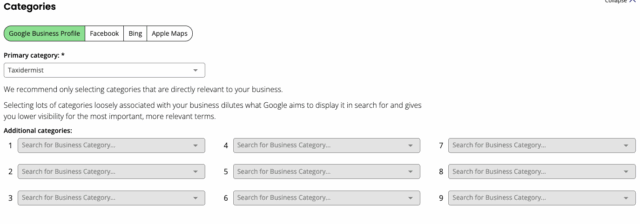
Things to Consider for Effective Listings Management
To truly master your business listings, consider the following key things:
Crafting a Business Description
Your business description is often the first impression a new customer has. It should be clear, succinct, and highlight your unique selling points, products, and services. Keep character limits in mind for platforms like: Google (750 characters) and Apple Maps (500 characters), and always avoid keyword stuffing. Active Sync can help you manage and update these descriptions efficiently across platforms.
Using Phone Tracking Numbers or URLs
While most major platforms don’t strictly prohibit tracking numbers or URLs, be cautious when using them. Google, Apple, and Bing generally allow them as long as they connect directly to your business location and you have direct control.
However, consistency is key: using different tracking numbers can confuse both consumers and search engines.
How Frequently to Update and Optimize Your Listing
Your listings should be living documents, updated as often as necessary to reflect any changes in your business. This includes:
- Seasonal or special opening hours
- Changes to products, services, or pricing
- New payment methods
- Updates to contact information
- Adding new photos and responding to reviews (at least weekly for Google Business Profile)
As mentioned, Active Sync enables you to push these critical updates instantly, ensuring your information is always current across all synced listings without having to update each platform manually.
The Smarter Way to Manage Listings
Discover a cutting-edge solution for effective listings management
Monitor and Audit Listings
Regularly auditing your business listings is a crucial yet often overlooked step. Over time, your business information can become outdated, duplicated, or even (as mentioned earlier) altered by third-party sources. If left unchecked, these inconsistencies can hurt your visibility, confuse customers, and destroy trust.
By making listing audits a regular part of your local SEO strategy, we’d suggest quarterly at minimum, you maintain control over how your business is represented online and ensure customers always find the right information when they need it.
Scan for and Eliminate Duplicate Listings
So, at least every quarter, scan for duplicates. Duplicate listings, especially on platforms like Google, Bing, and Yelp, can split your ranking power, confuse search engines, and send mixed signals about your business. Identifying and removing or merging them ensures you maintain a single, authoritative version of your business information across every directory.
Double-check Your Map Pins and Address Formatting
Next, verify the accuracy of your listing details, especially your map pins. A misplaced location pin on Google Maps or Apple Maps can send customers to the wrong place, leading to missed opportunities and frustration. Manually check that your business appears correctly on each platform and that the address formatting is consistent.
Use Tools to Monitor and Maintain Listing Health
Finally, use reliable tools to uncover issues and track your listing’s health. BrightLocal’s Citation Tracker can quickly highlight inconsistencies, duplicates, and missing information across major platforms. Tools like Active Sync not only help you manage updates but also monitor your listings in real time, flagging issues before they escalate.
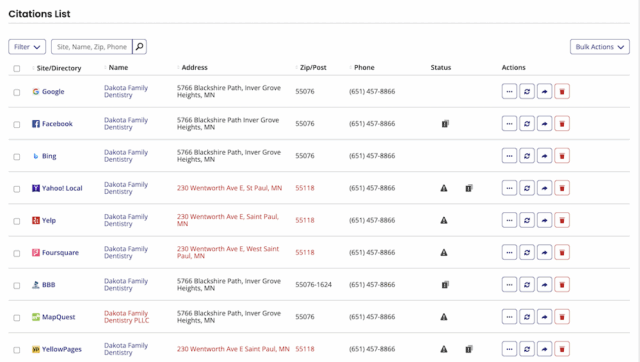
Monitor Google Business Profile Insights and Use UTM Tracking
Keeping tabs on how your listings are performing is just as important as managing the information they contain. Google Business Profile (GBP) provides valuable insights that show how customers are interacting with your listing, and these metrics can help guide your optimization efforts.
Here’s what you should be monitoring regularly:
- Website Clicks: See how many people are visiting your site directly from your GBP. If clicks are low, it might be time to refine your description, add clearer calls to action, or improve your images.
- Direction Requests: A high number of requests suggests strong local interest. If these numbers drop suddenly, it may signal that there’s an issue with your map pin or location info.
- Phone Calls: GBP Insights show when and how often people call your business. Use this data to track trends over time and see if certain days or promotions are generating more inquiries.
- Search Impressions: This shows how often your business appears in local search results. If you see a drop in these numbers it may indicate listing or SEO issues.
Tip: Our Google Business Profile Audit tool pulls key performance metrics directly from GBP and presents them in one clear, easy-to-read dashboard, helping you spot trends, diagnose problems, and track improvement over time.
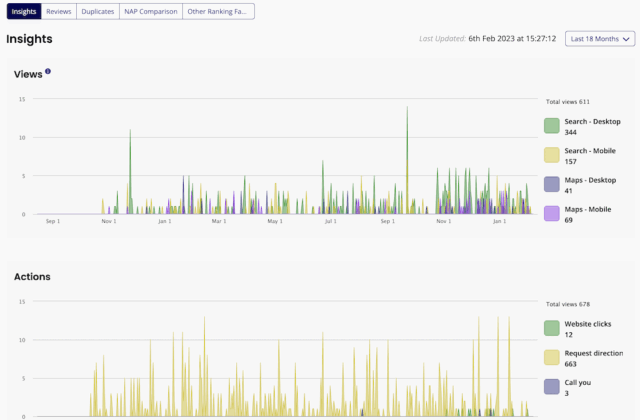
Additionally, to gain even more granular data on website traffic originating from your GBP, implementing UTM tracking is highly recommended. UTMs are simple code snippets you can add to the end of your URLs. When someone clicks a link with a UTM code, it sends specific information back to your Google Analytics (or other analytics tool), allowing you to see exactly where your website visitors came from and what campaign drove them.
For your GBP website link, you might use UTM parameters like:
-
utm_source=google_my_business -
utm_medium=organic -
utm_campaign=gmb_listing
This allows you to differentiate traffic from your GBP from other organic search traffic, providing a clearer picture of your listing’s performance in driving website visits.
Monitor and Respond to Reviews
Online reviews are more than just feedback; they’re one of the most influential trust signals for local consumers and search engines. When someone looks up your business on Google, Yelp, or Facebook, reviews are front and center. That makes review monitoring and responding a core part of effective listings management.
Ignoring your reviews (even the positive ones) means missing out on the chance to build stronger customer relationships, enhance your reputation, and boost your visibility in local search. In fact, 89% of consumers expect business owners to respond to all types of reviews, according to BrightLocal’s Local Consumer Review Survey.
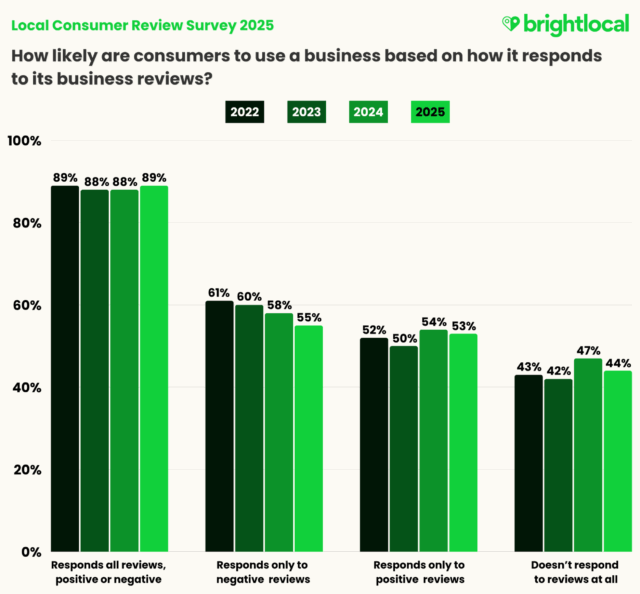
Best Practices for Review Management
- Monitor Reviews Across All Platforms
Keep an eye on your reviews. Each listing is a customer touchpoint that influences perception and buying decisions.
Tip: Use our Reputation Manager tool to monitor, manage, and respond to reviews across multiple platforms from one centralized dashboard.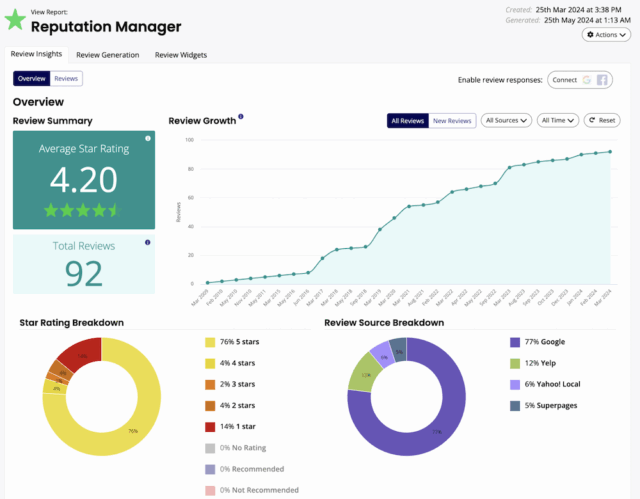
- Respond Promptly and Professionally
Make it a habit to respond to every review—positive or negative—ideally within 24–48 hours. Thank customers for kind words and address any issues in a polite, constructive manner. This not only reassures the original reviewer but also shows potential customers that you value feedback. - Spot Trends and Take Action
Pay attention to recurring themes in reviews. Are customers frequently mentioning slow service, unclear directions, or outdated business hours? These insights can signal problems in your operations or your listings that need addressing. - Encourage New Reviews
A steady stream of recent reviews signals to both customers and Google that your business is active and relevant. Make it easy for happy customers to leave reviews by sharing direct links, adding reminders in post-service emails, or using in-store signage.
Tip: With our Get Reviews feature, you can send review requests by email or SMS and direct happy customers to your preferred platforms.
How Abbreviations Affect NAP Consistency
NAP consistency is essential for local SEO. While Google and Bing are often smart enough to understand common abbreviations (e.g., ‘St.’ for ‘Street’), it’s best practice to maintain exact consistency across all listings. If you choose an abbreviation, stick to it everywhere. As mentioned already, Active Sync can help keep all your business info the same everywhere online. This stops confusing differences that could make it harder for people to find you in searches.
How to Manage Multiple Business Listings at the Same Time
Managing listings for a single business location is already a significant task, but when you operate multiple branches or franchise locations, that complexity multiplies. Each location may have unique hours, services, contact details, and reviews to manage. Without the right systems in place, things can quickly spiral into inconsistency and confusion.
Here’s how to effectively manage multiple business listings without losing control:
Use a Centralized Listings Management Platform
The key to managing multiple locations efficiently is centralization. A tool like Active Sync becomes indispensable when handling multiple listings. It allows you to:
- Control all listings from one dashboard: Manage every location’s information from a single interface instead of logging into separate accounts
- Maintain location-specific information: Even with centralized management, you can customize descriptions, categories, and attributes for each location to reflect local differences.
- Stay on top of suggested edits and duplicates: Active Sync monitors each listing for third-party edits or duplicate entries, alerting you so you can act before issues impact your visibility.
Centralize Review Management
With multiple listings, reviews can come in from many platforms and locations simultaneously. Using a tool like Reputation Manager, you can:
- Aggregate and track reviews from all major platforms
- Get notified of new reviews in real-time
- Respond quickly and consistently, maintaining a strong brand voice across all locations
This central approach helps to ensure no customer feedback slips through the cracks and reinforces trust with both search engines and potential customers.

Leverage Google Business Profile Manager
For businesses with multiple locations on Google, the Google Business Profile Manager is essential. It allows you to:
- Create and manage profiles in bulk
- Organize listings using business groups
- Apply updates across multiple locations simultaneously
- Share access with team members or franchise managers, with controlled permissions
This ensures your presence on Google remains consistent, accurate, and easy to manage at scale.
Assign Roles and Responsibilities
If multiple team members are involved in listings management, clearly define who’s responsible for what. Whether it’s updating business hours, responding to reviews, or conducting regular audits, assigning specific tasks ensures:
- Accountability
- Timely updates
- Fewer errors or oversights
Monitor Performance Across All Locations
Tracking performance by location helps you understand what’s working and where improvements are needed. Use tools like BrightLocal, Google Business Profile Insights, Google Analytics, and Google Search Console to monitor key metrics such as:
- Website clicks: To measure engagement and conversion potential
- Direction requests: To track local demand
- Call volume: To identify peaks in customer interest
- Search impressions: To evaluate overall local visibility
This data enables you to identify top-performing branches, optimize underperforming listings, and catch issues like outdated info or negative reviews before they impact your reputation.
Conclusion
Managing your business listings properly is an ongoing process that requires attention to detail and consistent effort. By understanding the nuances of listings management, differentiating it from simple citation building, and leveraging powerful tools like BrightLocal’s Active Sync, you can ensure your business information is always accurate, optimized, and working hard to attract and retain local customers.